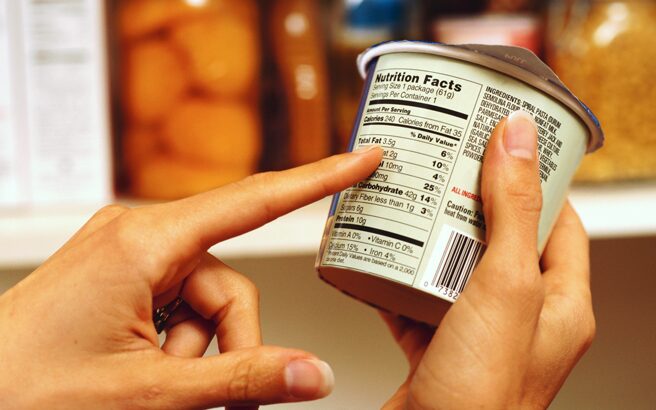 Ioana Vlad is one of our Policy and Public Affairs Officers. She is a health policy researcher with a longstanding interest in the politics of evidence-informed policy-making.
Ioana Vlad is one of our Policy and Public Affairs Officers. She is a health policy researcher with a longstanding interest in the politics of evidence-informed policy-making.
Understanding food labels
When you buy your food, do you feel you have enough information to select the best products?
Food labels are important, as I discovered years ago when I found myself between the aisles of a Swedish supermarket – a recently arrived foreign student that didn’t speak the language – not really understanding what any of the labels for pre-prepared food said. I opted for things I already knew: veggies, bread, cheese, and fruit. It would be some time till I tried the tube of prawn-flavoured cheese that looked more like toothpaste (it turned out that it wasn’t for me).
Food labels don’t only tell us what our food is, they tell us what kind of nutrients it contains and signal to us what foods we should avoid – such as those high in sugar, fat or salt. As obesity rates rise across the globe, it is important we know what is in our food. But often, we don’t have time to read those labels, or we don’t quite understand what the long lists on the back of the package mean. So how can we know which foods to choose? Are the foods advertised as healthy actually good for us?
Front-of-pack labels – what are they?
In recent years, governments around the world have introduced a simpler and faster way to present nutritional information to consumers. These are front-of-pack labels – one of a number of policy measures governments can implement to improve the food environment. As the name suggests, they are placed on the front of food packaging, they are simpler than the small writing on the back and tell us, at a glance: this food is good or bad for you.
In the UK, starting in 2006, the government introduced a system called the Multiple Traffic Light system. This system tells consumers if foods are high in calories, sugar, fat and salt using the colours scheme red, amber, green. If all are coded red, the message is simple – this food is bad for you and should be a very occasional treat. If most are coded green, but, say, salt is coded yellow/amber – this food doesn’t add extra sugar, fat or calories, but you should think about reducing salt from another part of your diet.

Packets of pre-cooked rice displaying their nutritional ingredients per serving
Other governments across the world have developed different types of front-of-pack labels. For example, in France, food gets an overall score from A to E by calculating information about important nutrients using the Nutri-Score system, with the A scoring healthier than D or E.
In contrast in Chile, all foods that are unhealthy are marked with a black warning logo or seal that states “High in calories” or “High in salt/sugar/fat”. If all those nutrients are high, a product can get as many as four black seals. This system is mandatory, which incentivises food and drink producers to lower the levels of these nutrients so consumers don’t stop buying their products. In Sweden, only healthy products carry an endorsement logo, known as the Keyhole logo – though I am not quite sure if the prawn-flavoured cheese would have carried one.
What works best – the evolution of front-of-pack labels
Front-of-pack labels continue to evolve – what was innovative 10 years ago is no longer current. We simply know more. Recognising this evolution, the UK government recently opened a consultation on what changes are necessary to the UK front-of-pack traffic light labels and whether the systems in France or Chile could be used instead. This consultation gives the public, food manufacturers, and organisations such as WCRF, the opportunity to state their preference. And in our case, to provide evidence on which front-of-pack labels could work best in the UK.
At WCRF we take a keen interest in what other countries around the world are doing, and we monitor how their labels perform and what impact they have. All this information is gathered in our NOURISHING database. Moreover, we distilled lessons learned on front-of-pack labelling systems from around the world in our Building Momentum report. Based on this evidence, it is clear that simpler labels (such as Nutri-Score) are understood better than more complex ones (such as the Multiple Traffic Light system). It is also clear that front-of-pack labels should be mandatory because otherwise, manufacturers of unhealthy foods do not have any incentive to examine the nutrient levels in their food products and produce healthier food. The current system in the UK is voluntary – this means that not all foods carry front-of-pack labels.
Lastly, for a front-of-pack label to be successful, consumers should be clearly informed about its existence and message. In a world where newer and more complex foods arrive on shelves all the time, people from all walks of life need accessible and clear information. Simply put, if the tubes of prawn cheese ever make it to your local supermarket, you’d want to know what’s in them.
